Effect of Various Silica Nanofluids: Reduction of Fines Migrations and Surface Modification of Berea Sandstone
Abstract
:1. Introduction
2. Materials and Methods
2.1. Nanofluid Preparation
- Silica dispersed in DIW.
- Sulfonated silica dispersed in DIW (functionalized).
- Silica dispersed in DIW with MPTMS stabilizing fluid.
2.2. NP Functionalization
2.3. Particle Size and Zeta Potential Measurement
2.4. Introduction of Silica Nanofluids to the Porous Medium
2.5. Nanofluid Stability and Determination of NP Concentration
2.6. Determination of MPTMS Concentration in Effluent
2.7. Isothermal Static Adsorption Experiments
2.8. Surface Forces
3. Results and Discussion
3.1. Unmodified Silica Nanofluids
3.2. Nanofluids Stabalized by MPTMS
3.3. Sulfonated Silica Nanofluids
3.4. Adsorption of NP on Minerals
3.5. Interaction between Fines and Porous Media
4. Conclusions
Acknowledgments
Author Contributions
Conflicts of Interest
References
- Abhishek, R.; Kumar, G.S.; Sapru, R. Wettability alteration in carbonate reservoirs using nanofluids. Pet. Sci. Technol. 2015, 33, 794–801. [Google Scholar] [CrossRef]
- Behzadi, A.; Mohammadi, A. Environmentally responsive surface-modified silica nanoparticles for enhanced oil recovery. J. Nanopart. Res. 2016, 18, 1–19. [Google Scholar] [CrossRef]
- Giraldo, J.; Benjumea, P.; Lopera, S.; Cortés, F.B.; Ruiz, M.A. Wettability alteration of sandstone cores by alumina-based nanofluids. Energy Fuels 2013, 27, 3659–3665. [Google Scholar] [CrossRef]
- Li, S.; Torsæter, O. Experimental investigation of the influence of nanoparticles adsorption and transport on wettability alteration for oil wet berea sandstone. In Proceedings of the SPE Middle East Oil & Gas Show and Conference, Manama, Bahrain, 8–11 March 2015; Society of Petroleum Engineers: Richardson, TX, USA, 2015. [Google Scholar]
- Shahrabadi, A.; Bagherzadeh, H.; Roostaie, A.; Golghanddashti, H. Experimental investigation of hlp nanofluid potential to enhance oil recovery: A mechanistic approach. In Proceedings of the SPE International Oilfield Nanotechnology Conference and Exhibition, Noordwijk, The Netherlands, 12–14 June 2012; Society of Petroleum Engineers: Richardson, TX, USA, 2012. [Google Scholar]
- Sheshdeh, M.J. A review study of wettability alteration methods with regard to nano-materials application. In Proceedings of the SPE Bergen One Day Seminar, Bergen, Norway, 22 April 2015; Society of Petroleum Engineers: Richardson, TX, USA, 2015. [Google Scholar]
- Zhang, H.; Nikolov, A.; Wasan, D. Enhanced oil recovery (EOR) using nanoparticle dispersions: Underlying mechanism and imbibition experiments. Energy Fuels 2014, 28, 3002–3009. [Google Scholar] [CrossRef]
- Arab, D.; Pourafshary, P. Nanoparticles-assisted surface charge modification of the porous medium to treat colloidal particles migration induced by low salinity water flooding. Colloids Surf. A Physicochem. Eng. Asp. 2013, 436, 803–814. [Google Scholar] [CrossRef]
- Arab, D.; Pourafshary, P.; Ayatollahi, S.; Habibi, A. Remediation of colloid-facilitated contaminant transport in saturated porous media treated by nanoparticles. Int. J. Environ. Sci. Technol. 2014, 11, 207–216. [Google Scholar]
- Hendraningrat, L.; Li, S.; Torsæter, O. A coreflood investigation of nanofluid enhanced oil recovery. J. Pet. Sci. Eng. 2013, 111, 128–138. [Google Scholar]
- Hendraningrat, L.; Torsæter, O. Metal oxide-based nanoparticles: Revealing their potential to enhance oil recovery in different wettability systems. Appl. Nanosci. 2015, 5, 181–199. [Google Scholar] [CrossRef]
- Ogolo, N.; Olafuyi, O.; Onyekonwu, M. Enhanced oil recovery using nanoparticles. In Proceedings of the SPE Saudi Arabia Section Technical Symposium and Exhibition, Al-Khobar, Saudi Arabia, 8–11 April 2012; Society of Petroleum Engineers: Richardson, TX, USA, 2012. [Google Scholar]
- Suleimanov, B.; Ismailov, F.; Veliyev, E. Nanofluid for enhanced oil recovery. J. Pet. Sci. Eng. 2011, 78, 431–437. [Google Scholar] [CrossRef]
- Hofmann, U.; Endell, K.; Wilm, D. Röntgenographische und kolloidchemische untersuchungen über ton. Angew. Chem. 1934, 47, 539–547. [Google Scholar] [CrossRef]
- Metin, C.O.; Lake, L.W.; Miranda, C.R.; Nguyen, Q.P. Stability of aqueous silica nanoparticle dispersions. J. Nanopart. Res. 2011, 13, 839–850. [Google Scholar] [CrossRef]
- Ortega, D.J.S.; Kim, H.B.; James, L.A.; Johansen, T.E.; Zhang, Y. The effectiveness of silicon dioxide SiO2 nanoparticle as an enhanced oil recovery agent in ben nevis formation, hebron field, offshore eastern canada. In Proceedings of the Abu Dhabi International Petroleum Exhibition & Conference, Abu Dhabi, UAE, 7–10 November 2016; Society of Petroleum Engineers: Richardson, TX, USA, 2016. [Google Scholar]
- Hendraningrat, L.; Torsæter, O. A stabilizer that enhances the oil recovery process using silica-based nanofluids. Transp. Porous Media 2015, 108, 679–696. [Google Scholar] [CrossRef]
- Yang, X.; Liu, Z.-H. A kind of nanofluid consisting of surface-functionalized nanoparticles. Nanoscale Res. Lett. 2010, 5, 1324. [Google Scholar] [CrossRef] [PubMed]
- Weston, J.S.; Jentoft, R.E.; Grady, B.P.; Resasco, D.E.; Harwell, J.H. Silica nanoparticle wettability: Characterization and effects on the emulsion properties. Ind. Eng. Chem. Res. 2015, 54, 4274–4284. [Google Scholar] [CrossRef]
- Zhang, T.; Murphy, M.J.; Yu, H.; Bagaria, H.G.; Yoon, K.Y.; Nielson, B.M.; Bielawski, C.W.; Johnston, K.P.; Huh, C.; Bryant, S.L. Investigation of nanoparticle adsorption during transport in porous media. SPE J. 2014. [Google Scholar] [CrossRef]
- Wang, W.; Yuan, B.; Su, Y.; Wang, K.; Jiang, M.; Moghanloo, R.G.; Rui, Z. Nanoparticles adsorption, straining and detachment behavior and its effects on permeability of berea cores: Analytical model and lab experiments. In Proceedings of the SPE Annual Technical Conference and Exhibition, Dubai, UAE, 26–28 September 2016; Society of Petroleum Engineers: Richardson, TX, USA, 2016. [Google Scholar]
- Tabrizy, V.A.; Denoyel, R.; Hamouda, A. Characterization of wettability alteration of calcite, quartz and kaolinite: Surface energy analysis. Colloids Surf. A Physicochem. Eng. Asp. 2011, 384, 98–108. [Google Scholar] [CrossRef]
- Mondragon, R.; Julia, J.E.; Barba, A.; Jarque, J.C. Characterization of silica–water nanofluids dispersed with an ultrasound probe: A study of their physical properties and stability. Powder Technol. 2012, 224, 138–146. [Google Scholar] [CrossRef]
- Oh, Y.-K.; Hong, L.-Y.; Asthana, Y.; Kim, D.-P. Synthesis of super-hydrophilic mesoporous silica via a sulfonation route. J. Ind. Eng. Chem. 2006, 12, 911–917. [Google Scholar]
- Seetha, N.; Majid Hassanizadeh, S.; Kumar, M.; Raoof, A. Correlation equations for average deposition rate coefficients of nanoparticles in a cylindrical pore. Water Resour. Res. 2015, 51, 8034–8059. [Google Scholar] [CrossRef]
- Khilar, K.C.; Fogler, H.S. Migrations of Fines in Porous Media; Springer Science & Business Media: New York, NY, USA, 1998; Volume 12. [Google Scholar]
- Dunphy Guzman, K.A.; Finnegan, M.P.; Banfield, J.F. Influence of surface potential on aggregation and transport of titania nanoparticles. Environ. Sci. Technol. 2006, 40, 7688–7693. [Google Scholar] [CrossRef]
- Israelachvili, J.N. Intermolecular and Surface Forces; Academic Press: Cambridge, MA, USA, 2011. [Google Scholar]
- Yuan, H.; Shapiro, A.A. Induced migration of fines during waterflooding in communicating layer-cake reservoirs. J. Pet. Sci. Eng. 2011, 78, 618–626. [Google Scholar] [CrossRef] [Green Version]
- Huang, T.; Han, J.; Agrawal, G.; Sookprasong, P. Coupling nanoparticles with waterflooding to increase water sweep efficiency for high fines-containing reservoir-lab and reservoir simulation results. In Proceedings of the SPE Annual Technical Conference and Exhibition, Houston, TX, USA, 28–30 September 2015; Society of Petroleum Engineers: Richardson, TX, USA, 2015. [Google Scholar]
- Metin, C.O.; Baran, J.R.; Nguyen, Q.P. Adsorption of surface functionalized silica nanoparticles onto mineral surfaces and decane/water interface. J. Nanopart. Res. 2012, 14, 1246. [Google Scholar] [CrossRef] [PubMed]
- Kia, S.; Fogler, H.; Reed, M. Effect of ph on colloidally induced fines migration. J. Colloid Interface Sci. 1987, 118, 158–168. [Google Scholar] [CrossRef]
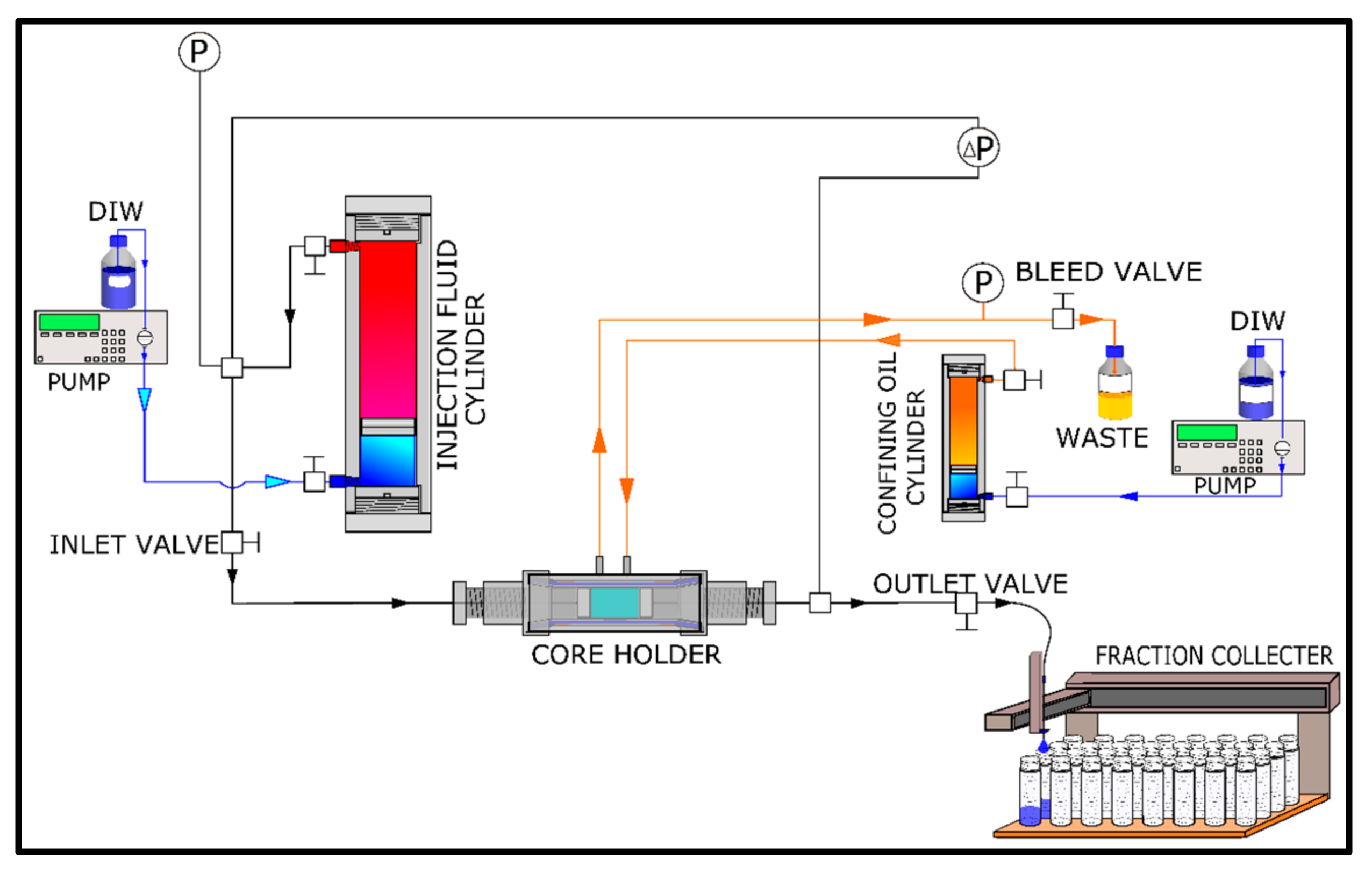
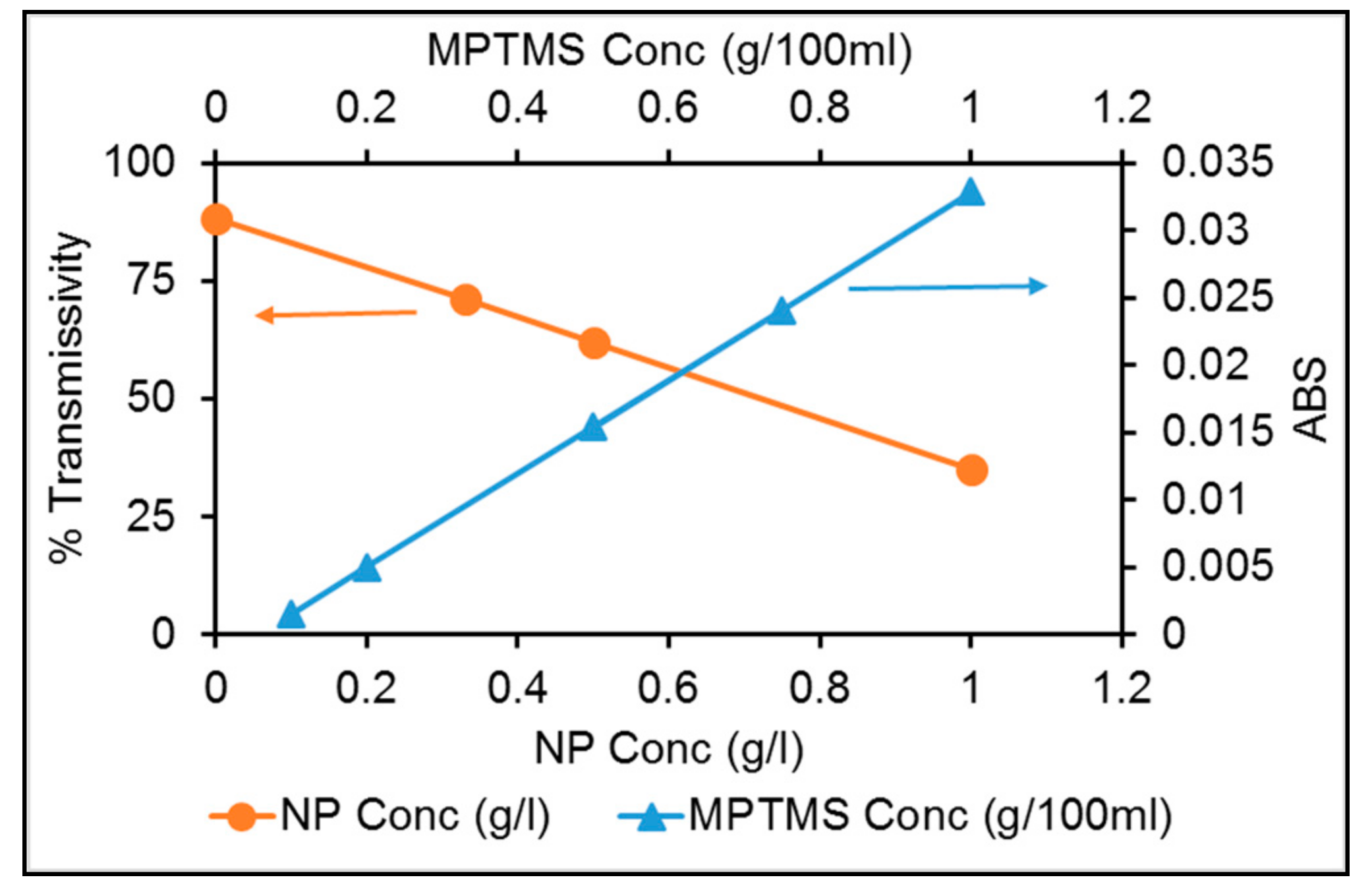
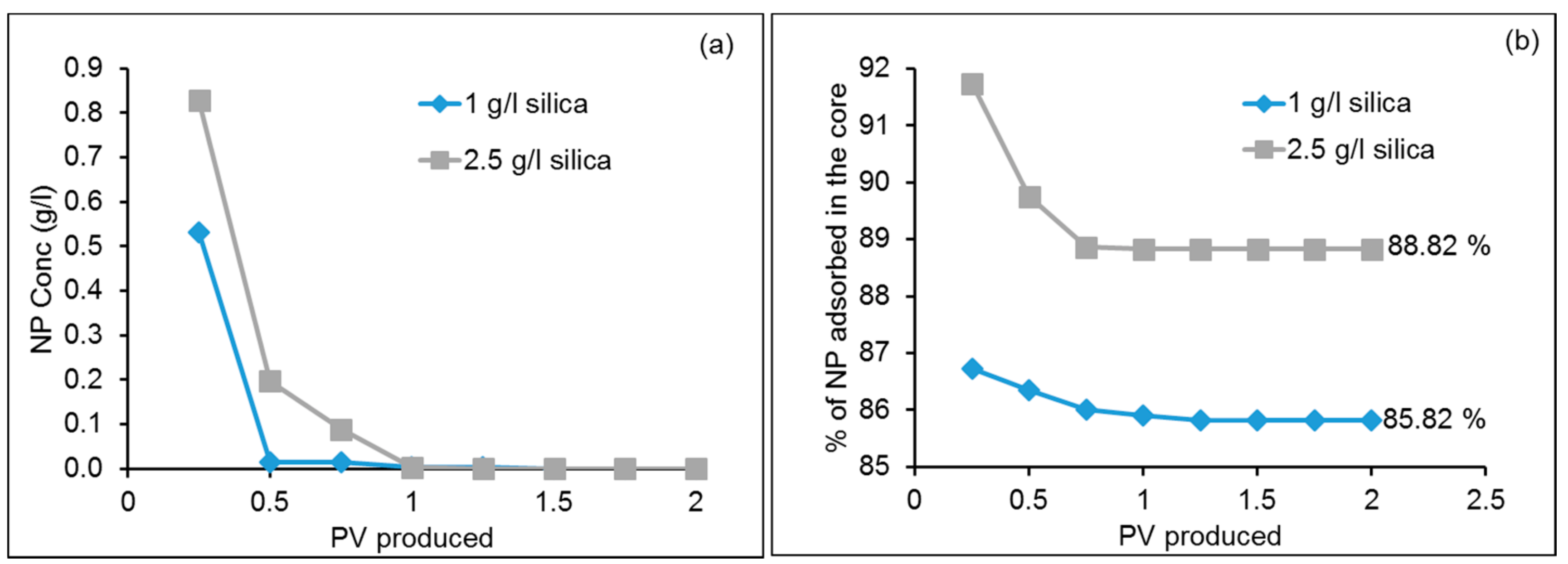
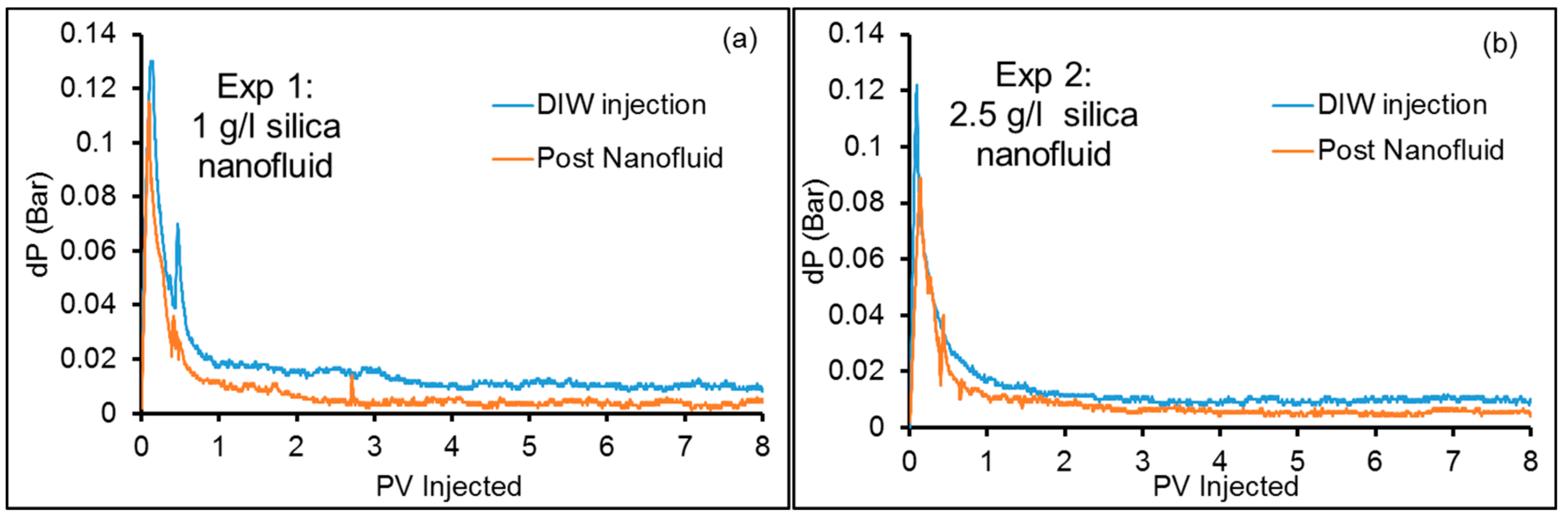
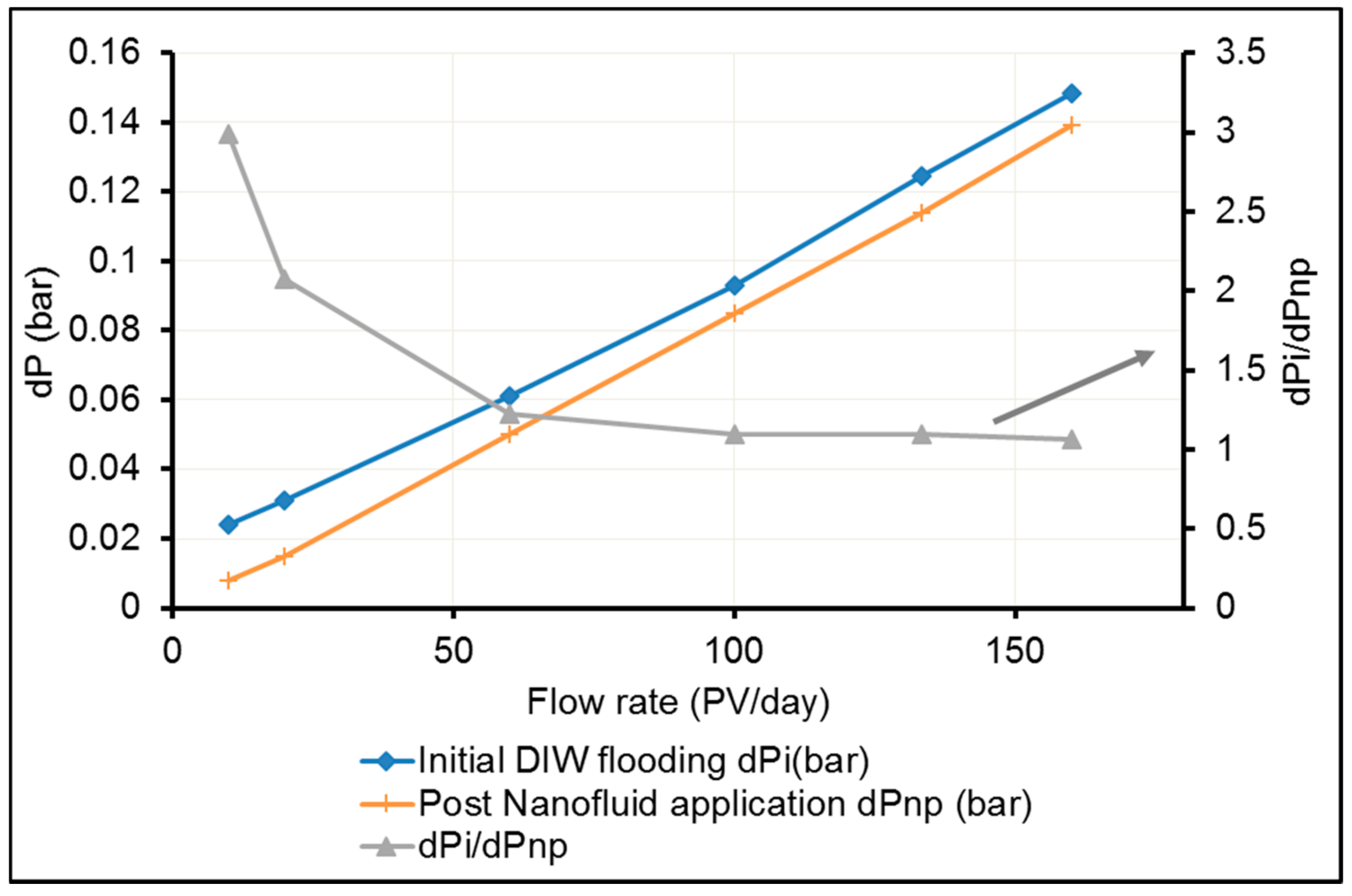

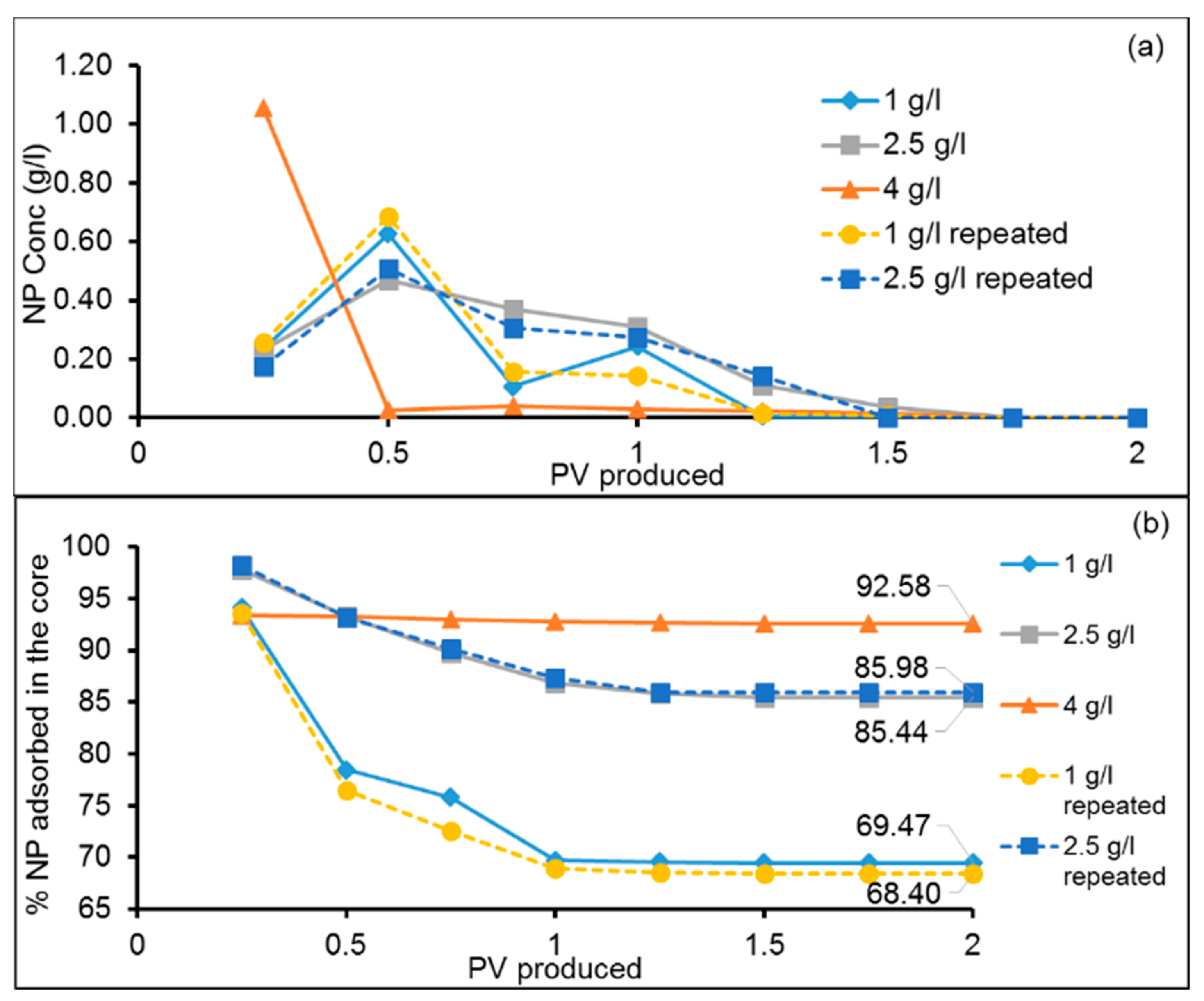
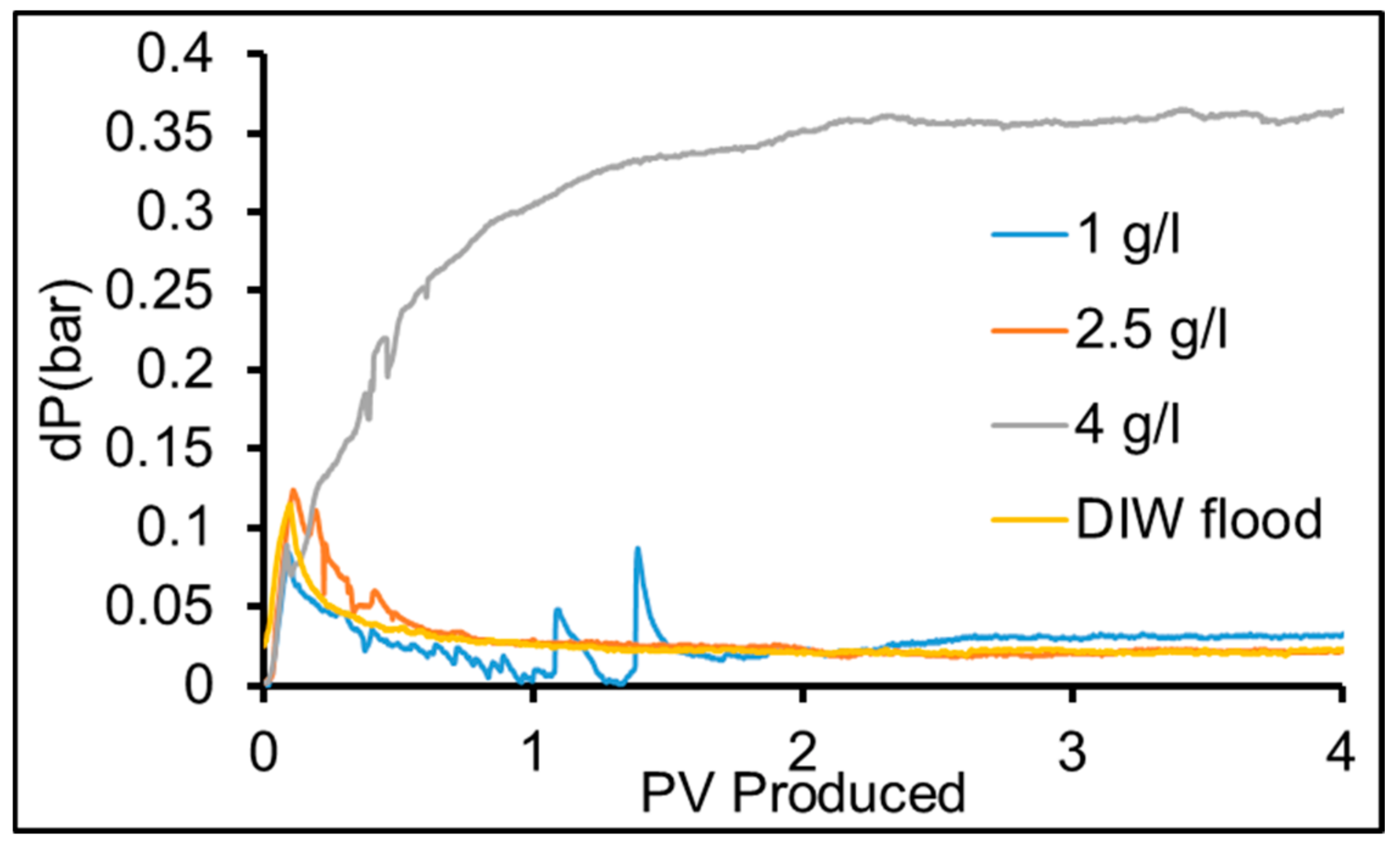

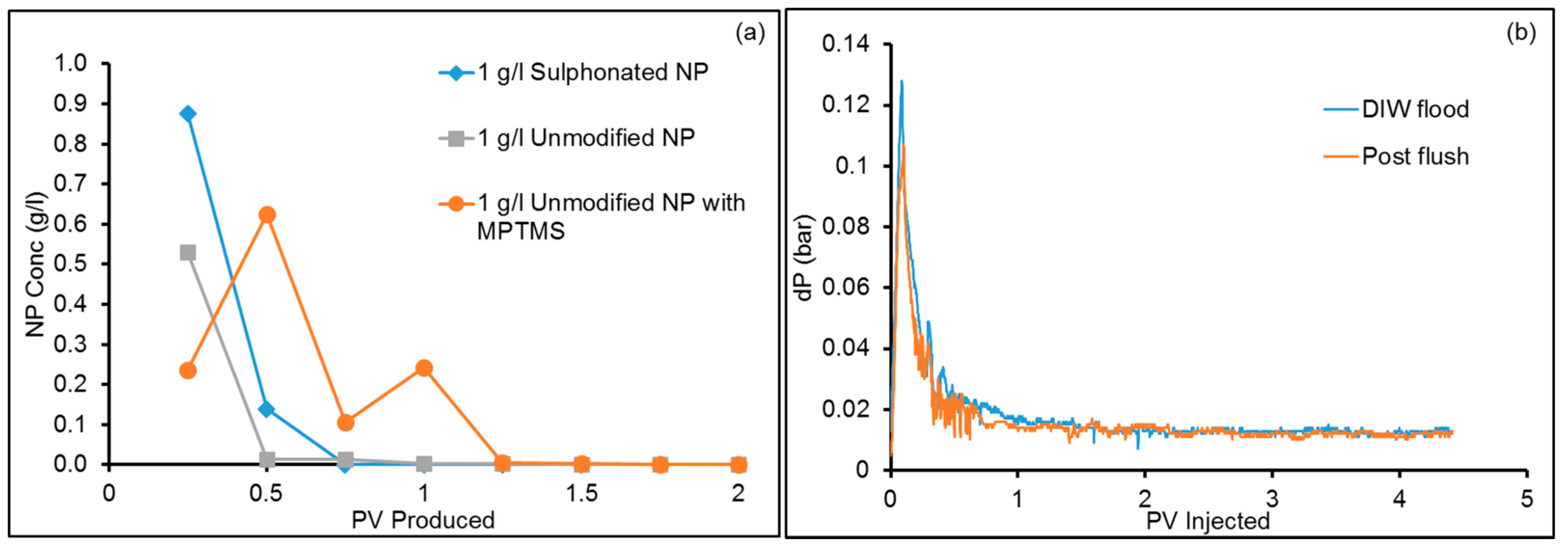

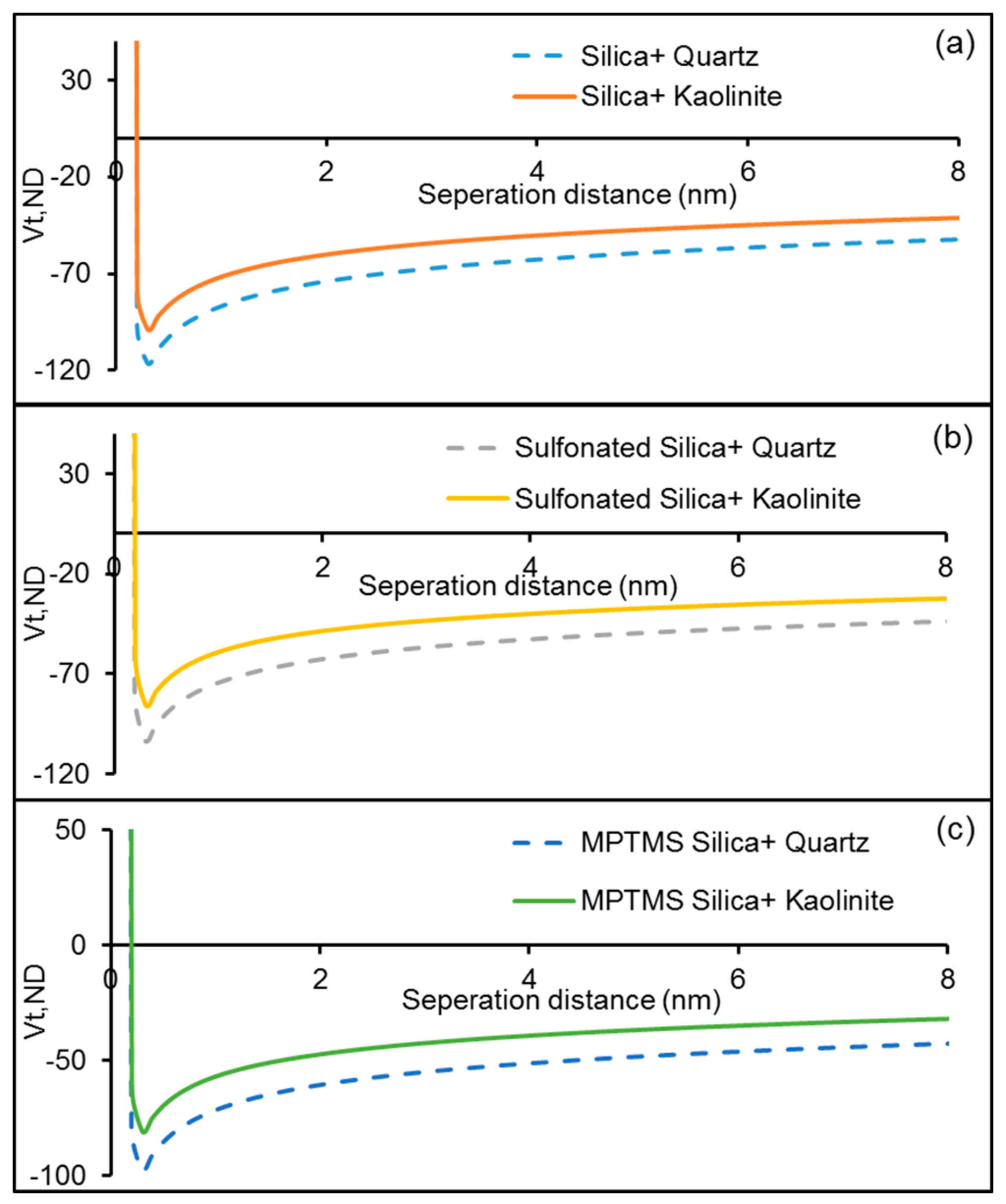
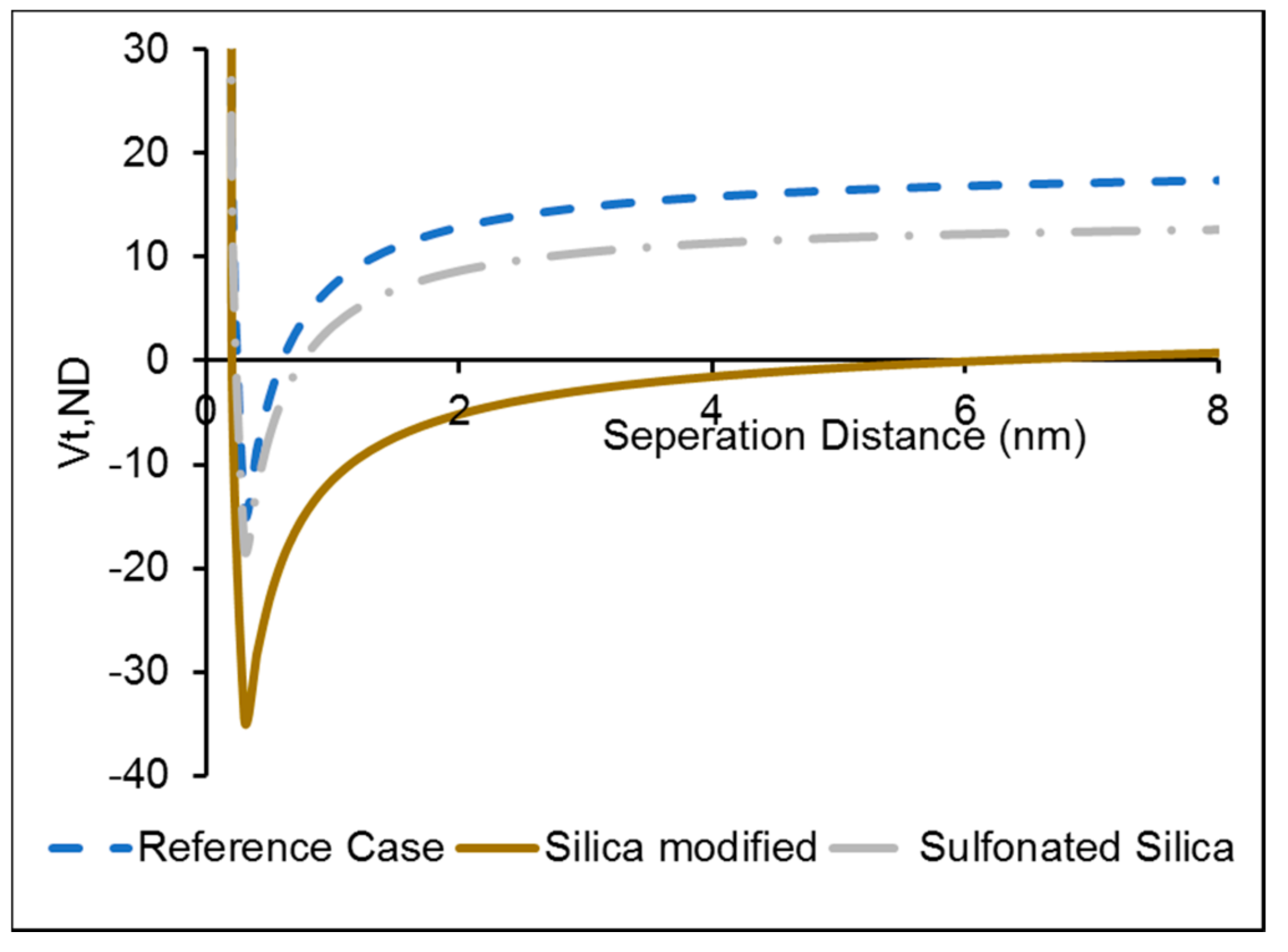
| Core Properties | Mineral Composition of Berea | ||
|---|---|---|---|
| Type | Berea Sandstone | Mineral Name | Semi-Quantitative (%) |
| Length | 8.95 ± 0.08 cm | Quartz | 94 |
| Diameter | 3.78 cm | Kaolinite | 1 |
| Porosity | 20.05 ± 0.76% | Muscovite | 1 |
| Permeability | 200–220 mD | Microline | 1 |
| Material | Conc (g/L) | Dispersing Phase | Zeta Potential (mV) | Particle Radius (nm) | Method |
|---|---|---|---|---|---|
| Silica | 1 | DIW | −51.45 | 161.2 | DLS |
| Sulfonated Silica | 1 | DIW | −44.8 | 182.9 | DLS |
| Silica | 1 | DIW + 1 g/100 mL MPTMS | −47.75 | 153.3 | DLS |
| Powdered Berea | 10 | DIW | −29.53 | NA | ESA |
| Quartz powder | 10 | DIW | −5.732 | NA | ESA |
| Kaolinite powder | 10 | DIW | −9.097 | NA | ESA |
| Experiment No. | NP Conc. (g/L) | Type of NP | Dispersing Phase | Comments |
|---|---|---|---|---|
| 1 | 1 | Silica | DIW | |
| 2 | 2.5 | Silica | DIW | |
| 3 | 1 | Silica | DIW | Performed at varying injection rates |
| 4 | 1 | Silica | DIW + MPTMS (1 g/100 mL) | |
| 5 | 2.5 | Silica | DIW + MPTMS (1 g/100 mL) | |
| 6 | 4 | Silica | DIW + MPTMS (1 g/100 mL) | |
| 7 | 1 | Silica | DIW + MPTMS (1 g/100 mL) | Repeated Experiment 4 |
| 8 | 2.5 | Silica | DIW + MPTMS (1 g/100 mL) | Repeated Experiment 5 |
| 9 | 1 | Sulfonated | DIW |
| Radius of Fine Particles (nm) | Intensity (%) |
|---|---|
| 233.8 | 73.0 |
| 68.57 | 24.2 |
| 2687 | 2.8 |
© 2017 by the authors. Licensee MDPI, Basel, Switzerland. This article is an open access article distributed under the terms and conditions of the Creative Commons Attribution (CC BY) license (http://creativecommons.org/licenses/by/4.0/).
Share and Cite
Abhishek, R.; Hamouda, A.A. Effect of Various Silica Nanofluids: Reduction of Fines Migrations and Surface Modification of Berea Sandstone. Appl. Sci. 2017, 7, 1216. https://doi.org/10.3390/app7121216
Abhishek R, Hamouda AA. Effect of Various Silica Nanofluids: Reduction of Fines Migrations and Surface Modification of Berea Sandstone. Applied Sciences. 2017; 7(12):1216. https://doi.org/10.3390/app7121216
Chicago/Turabian StyleAbhishek, Rockey, and Aly A. Hamouda. 2017. "Effect of Various Silica Nanofluids: Reduction of Fines Migrations and Surface Modification of Berea Sandstone" Applied Sciences 7, no. 12: 1216. https://doi.org/10.3390/app7121216





